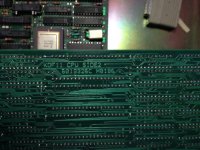vladstamate
Experienced Member
Hi all,
I am trying to figure out how much memory I have in my PDP-11/23. The individual (gold) chips are TMS4164. A quick Google search indicates that they are 64kilobits each. There are 32 of them so that would make 256KBytes of memory. Is that a normal amount for a PDP-11/23 system?
memory board
If one wants more memory one adds another memory board to the system or can there be just one memory board? In case of multiple memory boards, do they have to be same size?
Regards,
Vlad.
I am trying to figure out how much memory I have in my PDP-11/23. The individual (gold) chips are TMS4164. A quick Google search indicates that they are 64kilobits each. There are 32 of them so that would make 256KBytes of memory. Is that a normal amount for a PDP-11/23 system?
memory board
If one wants more memory one adds another memory board to the system or can there be just one memory board? In case of multiple memory boards, do they have to be same size?
Regards,
Vlad.

